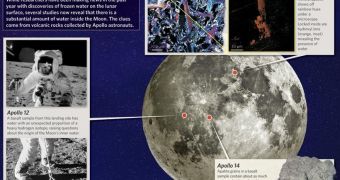The last year or so was a very intense period, with many missions to the planet's natural satellite discovering water deposits on the Moon. Granted, they are stored as water-ice, in craters that never see the light of day, but they are there nonetheless. In addition, even rocks collected by astronauts from the Apollo missions recently revealed that they contained relatively high concentrations of water inside, up to several parts per million. Surface studies, and investigations of the soil therefore revealed that water is everywhere on the Moon, which shouldn't be the case. Therefore, experts are beginning to wonder what the origin of the origin of the body may be, Nature News reports.
The Chandrayaan-1 orbiter, belonging to the Indian Space Research Organization (ISRO), the Lunar Reconnaissance Orbiter (LRO), and the LCROSS, both NASA spacecrafts, showed signs of water on the surface of the Moon from high in orbit. But their findings also imply something else – that comets may have played a much more important role in endowing the inner solar system (Mars, Earth and the Moon) with their respective amounts of water than previously thought. Currently, there are new theories being proposed in the international scientific community, which say that the atmosphere and the oceans on our planet are of extraterrestrial origins, as in that they were delivered by comets.
Speaking at the annual Lunar and Planetary Science Conference, held in Houston, Texas, three research teams presented separate evidence of water on the Moon, and all concluded – through different means – that the interior of our natural satellite has to contain several times more water than initially thought. However, the researchers say, it still contains much less than our planet does. If this is true, then the implications are massive. Water allows for the mantle to form lava, and promotes convection motions inside this layer. That, in turn, means that that Moon could develop, or may have had, a magnetic shield similar to the one Earth has now.
In addition, investigators add that the new discoveries may help clear out some mysteries related to lunar geology that cannot be explained through other means. A Moon with more moisture in its innards may have cooled more rapidly after it was formed, thus explaining why some of its rocks are very peculiar, and do not fit existing models on how the natural satellite formed. By analyzing the deuterium ratio in the water, experts even managed to conclude that it features a much higher concentration of heavy hydrogen than our planet’s, which is a definite indicator of cometary origins.

 14 DAY TRIAL //
14 DAY TRIAL //